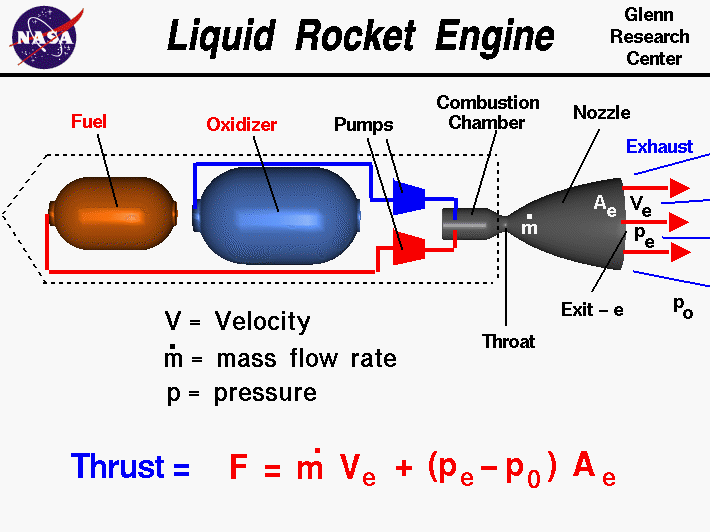There are a few main parts to a rocket; nose cone, fuselage, stabilizers, and engine. For rockets going to space they will have a guidance system and many sensors.
Amateur rockets will use the nose to store a parachute or not use it at all while space rockets put their payload in them. Just below will house a guidance system so the rocket knows where its going and makes the necessary corrections to stay on course. The fuselage will hold the main fuel tanks for the rocket's propulsion systems. The fins on the bottom of the rocket are stabilizers; they act similarly to the stabilizers on the tail of a plane, keeping the craft from spinning out on any of the 3 axis of flight. They also can move to change direction in flight like the control surfaces on a plane. The engine is the last part which is key to get off the ground.
Rocket engines are powerful pieces of machinery. Solid rockets ignite a chemical and it burns up. Liquid rocket engines will take fuel from the tanks and mix it thoroughly before combustion. The mix is sent to a combustion chamber then ignited. The exhaust gas goes through the throat at supersonic speed and expands around the cone applying newtons 3rd law. Forces from the expanding gas push on the cone giving it lifting force to get off the ground.
Rockets aren't that fuel efficient in general. The reason they're used so much is because rockets generate a lot of thrust; enough to get itself into space.
There are many types of rockets in means of propulsion devices.
Northwestern. "Propulsion." What Are the Types of Rocket Propulsion? Northwestern.edu, n.d. Web. 18 Dec. 2015. <http://www.qrg.northwestern.edu/projects/vss/docs/propulsion/2-what-are-the-types-of-rocket-propulsion.html>.
There are many types of rockets in means of propulsion devices.
- "The solid motor is used mainly as a booster for launch vehicles. Solid motors are almost never used in space because they are not controllable. The boosters are lit and then they fire until all the propellant has burned. Their main benefits are simplicity, a shelf life which can extend to years as in the case of missiles, and high reliability."
- "Liquid motors come in many shapes and sizes: Most of them are controllable (can be throttled up and down), restartable, are often used as control and maneuvering thrusters. Liquid thrusters can be broken into three main types: monopropellant, bipropellant, and cryogenic thrusters. Monopropellants only use one propellant such as hydrazine. Bipropellants use a fuel and an oxidizer such as RP-1 and H2O2. Cryogenic systems use liquefied gases such as LiH and LOX (liquid hydrogen and liquid oxygen). Cryogenic means super-cooled. You would have to super-cool hydrogen and oxygen to make them liquids. With each step from mono-propellant to bi-propellant to cryogenic the thruster complexity goes up but the performance also goes up.
- "Cold-gas motors have controllability similar to liquids but are the simpler and lighter. They are basically a high pressure tank with switches which flip between the open and shut state. They function a little like spray paint, with the contents under pressure inside, and when the valve is opened, they stream out."
- "Ion engines are vastly different from chemical (solid, liquid) engines in that they are low thrust engines which can run for extended periods of time. The length of use of chemical engines is usually from seconds to days while the length of use of ion engines can be anywhere from days to months."(Northwestern)
Northwestern. "Propulsion." What Are the Types of Rocket Propulsion? Northwestern.edu, n.d. Web. 18 Dec. 2015. <http://www.qrg.northwestern.edu/projects/vss/docs/propulsion/2-what-are-the-types-of-rocket-propulsion.html>.


No comments:
Post a Comment